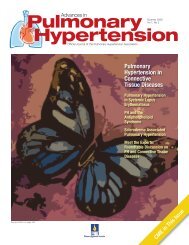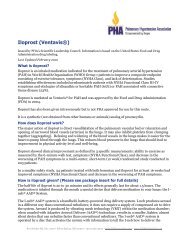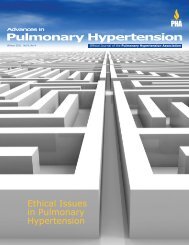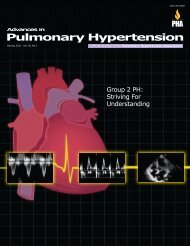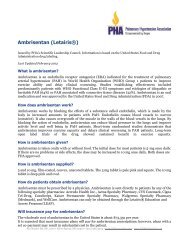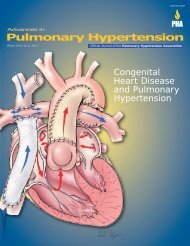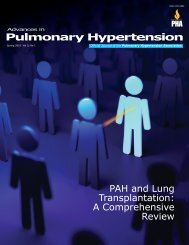Vol 7, No 3 - PHA Online University
Vol 7, No 3 - PHA Online University
Vol 7, No 3 - PHA Online University
Create successful ePaper yourself
Turn your PDF publications into a flip-book with our unique Google optimized e-Paper software.
lent correlation between impedance measurements and PVR as<br />
well as a correlation between impedance measurements and pulmonary<br />
vascular stiffness. 3,4<br />
The investigators have demonstrated that impedance can be<br />
measured routinely and easily in the cardiac catheterization laboratory.<br />
Most importantly, the investigators have demonstrated<br />
that impedance is a better predictor of disease outcome in pediatric<br />
patients with PAH than is simple measurement of PVR. 4<br />
Similar observations have been made in adult studies of PH by<br />
the SCCOR program at Johns Hopkins. They have demonstrated<br />
that impedance is a better and more effective way of evaluating<br />
PH than measuring PVR alone. Work in this project may establish<br />
improved methods to evaluate and follow the impact of pharmacological<br />
interventions in patients with PAH.<br />
Circulating Fibrocytes in Hyperoxic Lung<br />
Vascular Remodeling<br />
The long-term goal of Project 3 is to determine the role of circulating<br />
fibrocytes (precursors of mesenchymal cells) in neonatal<br />
lung vascular remodeling. There is good evidence that mesenchymal<br />
progenitor cells are recruited to the injured lung in<br />
young animals (mice, rats, calves) and play important roles in<br />
the pulmonary hypertensive process. 5 There are few data that<br />
demonstrate recruitment of progenitor cells to the vasculature of<br />
humans with PAH. Therefore, in collaboration with one of the<br />
major groups investigating adult PH (Vanderbilt <strong>University</strong>), tissues<br />
from patients with severe PAH were evaluated to determine<br />
the presence of cells expressing progenitor cell markers (CD133).<br />
A significant increase in the accumulation of CD133+ cells<br />
both in intimal lesions and in the perivascular regions of pulmonary<br />
arteries from patients with severe PH was observed. Because<br />
questions have arisen as to how these cells might affect<br />
vascular structure or function, we evaluated the possibility that<br />
they exerted their effects through a process of cell fusion and/or<br />
heterokaryon formation. This is one mechanism through which<br />
stem cells are often thought to exert their effects. Extensive<br />
analysis, however, did not demonstrate any evidence for fusion of<br />
these recruited cells to local vascular cells. 6 The recruited inflammatory/progenitor<br />
cells appear to exert effects on structure<br />
and function of blood vessels through processes other than cell<br />
fusion.<br />
These are important findings because they demonstrate that<br />
human PAH is associated with progenitor cell recruitment just<br />
as has been shown in animal models. We are currently collecting<br />
tissues from human infants with PH to carry out similar studies.<br />
In addition, we continue our efforts to determine the mechanisms<br />
through which inflammatory cells and progenitor cells are<br />
recruited to the lung. We are following up on our observations<br />
demonstrating that superoxide radical (O 2-<br />
) plays a critical role in<br />
initiating and perpetuating the remodeling process in the injured<br />
lung. 7,8 Having shown that transgenic overexpression of EC-SOD<br />
attenuated superoxide-induced signaling and dramatically attenuated<br />
PH and remodeling, we have embarked on studies (in<br />
collaboration with the <strong>University</strong> of Colorado Denver) to evaluate<br />
the effects of EC-SOD mimetics in rodent models of PH. 7<br />
Hypoxia-Inducible Factors in Neonatal PH<br />
The long-term goal of Project 4 is to develop agents that can<br />
specifically increase lung vascularization and thereby restore<br />
alveolarization to more normal levels. In important background<br />
studies the investigators established that hypoxia inducible factors<br />
(HIFs), important regulators of vascular endothelial growth<br />
factor (VEGF), are decreased in experimental acute lung injury. 9<br />
The investigators are testing the hypothesis that prolylhydroxylase<br />
inhibitors (PHDI), agents that stabilize the transcription factor<br />
HIF, can decrease PH in the newborn by restoring the fetal VEGF/<br />
eNOS axis. 10<br />
Unfortunately, in preliminary experiments, PHDIs were found<br />
to cause increased lethality in premature baboons, apparently due<br />
to immunomodulation with an exuberant inflammatory response<br />
(unpublished observation). These effects were thought to be due<br />
to overexpression of HIF1α. Therefore, the investigators have<br />
worked to develop methods to selectively activate HIF2α in the<br />
hopes that activation of this pathway will selectively result in protective<br />
angiogenic effects. The investigators have developed targeted<br />
stabilization of HIF2α, and they have demonstrated that<br />
overexpression of HIF2α increases adenosine A 2A<br />
receptor expression.<br />
Importantly, the investigators show that overexpression<br />
of adenosine A 2A<br />
receptor in endothelial cells can increase endothelial<br />
cell proliferation and endothelial branching. Thus, significant<br />
progress is being made in determining the mechanisms<br />
through which transcription factors can be selectively manipulated<br />
to achieve the desired beneficial effects in the neonatal lung.<br />
References<br />
1. Kinsella, JP. Inhaled nitric oxide in the term newborn. Early Hum Dev.<br />
2008;84:709-716.<br />
2. Kinsella JP, Abman SH. Inhaled nitric oxide in the premature newborn. J<br />
Pediatr. 2007;151:10-15.<br />
3. Hunter KS, Gross JK, Lanning CJ, et al. <strong>No</strong>ninvasive methods for determining<br />
pulmonary vascular function in children with pulmonary arterial hypertension:<br />
application of a mechanical oscillator model. Cong Heart Dis.<br />
2008;3:106-116.<br />
4. Hunter KS, Lee PF, Lanning CJ, et al. Pulmonary vascular input impedance<br />
is a combined measure of pulmonary vascular resistance and stiffness and<br />
predicts clinical outcomes better than PVR alone in pediatric patients with<br />
pulmonary hypertension. Am Heart J. 2008;155:166-174.<br />
5. Frid MG, Brunetti JA, Burke DL, et al. Hypoxia-induced pulmonary vascular<br />
remodeling requires recruitment of circulating mesenchymal precursors of a<br />
monocyte/macrophage lineage. Am. J. Pathol. 2006;168:659-669.<br />
6. Majka SM, Skokan M, Wheeler L, et al. Evidence for cell fusion is absent<br />
in vascular lesions associated with pulmonary arterial hypertension. Am J<br />
Physiol Lung Cell Mol Physiol. 2008;295:L1028-L1039. Epub 2008 Oct 17.<br />
7. <strong>No</strong>zik-Grayck E, Suliman HB, Majkaa SM, et al. Lung EC-SOD overexpression<br />
attenuates hypoxic induction of Egr-1 and chronic hypoxic pulmonary<br />
vascular remodeling. Am J Physiol Lung Cell Mol Physiol. 2008;295:<br />
L422-L430.<br />
8. <strong>No</strong>zik-Grayck E, Stenmark KR. Role of reactive oxygen species in chronic<br />
hypoxia-induced pulmonary hypertension and vascular remodeling. Adv Exp<br />
Med Biol. 2007;618:101-112.<br />
9. Grover TR, Asikainen TM, Kinsella JP, Abman SH, White CW. Hypoxia-inducible<br />
factors HIF-1alpha and HIF-2alpha are decreased in an experimental<br />
model of severe respiratory distress syndrome in preterm lambs. Am J<br />
Physiol Lung Cell Mol Physiol. 2007;292:L1345-51. Epub 2007 Feb 16.<br />
10. Asikainen TM, White CW. HIF stabilizing agents: shotgun or scalpel? Am<br />
J Physiol Lung Cel. Mol Physiol. 2007;293:L555-L556.<br />
342 Advances in Pulmonary Hypertension



